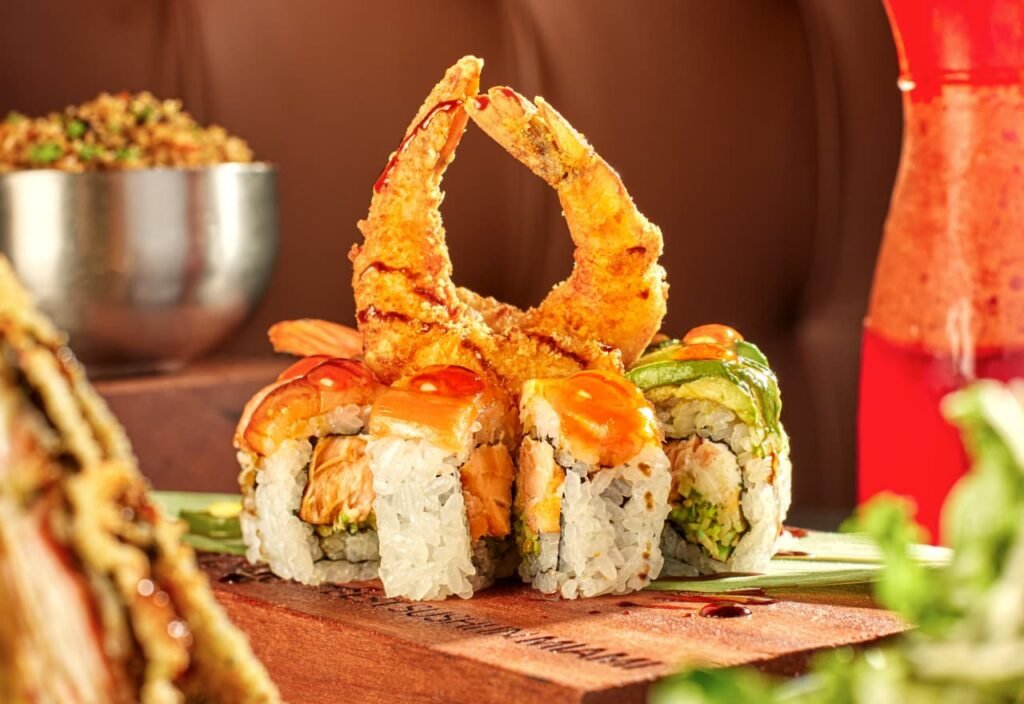Sushi, a beloved culinary tradition originating from Japan, has evolved over centuries to encompass a wide variety of styles and flavors. From the iconic rolls served in Japanese restaurants worldwide to the more traditional nigiri and sashimi, sushi offers a unique experience for every palate.
Understanding the different types of sushi not only enhances your dining experience but also deepens your appreciation for the artistry and precision involved in crafting each piece. Whether you’re new to sushi or a seasoned enthusiast, this guide will introduce you to the diverse options that make sushi a global favorite.
The beauty of sushi lies in its versatility, blending fresh ingredients with delicate techniques. While sushi is often associated with rice and fish, the combinations are endless, with variations such as maki, temaki, and chirashi presenting different textures, flavors, and presentation styles. Each type of sushi has its own distinct characteristics, influenced by regional preferences, seasonal ingredients, and the creativity of chefs. Join us as we dive into the world of sushi and explore the many types that have made this dish a timeless culinary delight.
Nigiri: The Simple Elegance of Hand-Pressed Sushi
Nigiri is one of the most iconic and traditional forms of sushi, celebrated for its simplicity and elegance. This sushi type consists of a small mound of vinegared rice, gently pressed by hand, and topped with a slice of fresh fish, seafood, or occasionally vegetables. The balance between the tender, slightly warm rice and the cool, smooth fish creates a harmonious flavor profile that highlights the quality and freshness of the ingredients. Traditionally, nigiri is served with a dab of wasabi between the rice and topping, enhancing the taste without overpowering the natural flavors.
While the technique behind making perfect nigiri is minimalistic, it requires immense skill. Sushi chefs spend years mastering the precise balance of rice texture and fish preparation to create nigiri that is both visually appealing and flavorful. The beauty of this sushi type lies in its ability to showcase the quality of the fish and the rice, without the need for elaborate garnishes or sauces. Nigiri has remained a favorite not only for its refined taste but also for its representation of sushi craftsmanship, with each piece being a testament to the chef’s dedication and expertise.
Maki: Rolled Sushi with Endless Variations
Maki sushi is one of the most popular and versatile types of sushi, known for its creative fillings and unique roll structures. Typically made by wrapping sushi rice and a variety of ingredients, such as fish, vegetables, or even fruit, in a sheet of nori (seaweed), maki rolls come in countless variations. From the classic tuna or salmon rolls to more inventive options like California rolls or spicy tuna, the possibilities are endless. Maki sushi can be enjoyed as simple, traditional rolls or transformed into elaborate creations, catering to all tastes and dietary preferences.
The beauty of maki lies in its adaptability and the endless combinations of ingredients that can be used. The rolls can be made in different sizes, from thin hosomaki to the larger uramaki, where the rice is on the outside. Maki is often served with a variety of accompaniments such as pickled ginger, wasabi, and soy sauce, which complement and enhance the flavors of the roll. Whether you prefer traditional flavors or enjoy exploring bold, modern twists, maki sushi offers an experience for everyone, making it a staple in both sushi restaurants and home kitchens around the world.
Sashimi: Pure Fish Perfection
Sashimi is the epitome of simplicity and purity in Japanese cuisine, focusing solely on the delicate flavors and textures of raw fish or seafood. Unlike other types of sushi, sashimi is served without rice, allowing the natural taste of the fish to shine through. Typically, fresh slices of tuna, salmon, or other seafood are presented in their most pristine form, often accompanied by a side of wasabi and soy sauce. The freshness of the fish is the star of the dish, making quality and sourcing essential for an authentic sashimi experience.
What makes sashimi truly remarkable is the artistry involved in its preparation. Each slice is cut with precision to ensure the perfect texture, size, and presentation. Sashimi chefs are highly skilled in selecting and handling fish, ensuring it is at peak freshness before it reaches the plate.
Whether served with a touch of ponzu sauce or simply seasoned with a dash of salt, sashimi remains a testament to the Japanese philosophy of letting the ingredients speak for themselves. For sushi lovers seeking a minimalist and sophisticated dish, sashimi offers an unmatched dining experience.
Temaki: The Hand Roll Revolution
Temaki, also known as hand rolls, is a fun and interactive variation of sushi that allows you to enjoy the fresh flavors of sushi in a more casual, handheld format. Unlike traditional sushi rolls, temaki is made by rolling a cone-shaped piece of nori filled with sushi rice, fresh seafood, vegetables, and sometimes even fruits like avocado or mango.
Its unique shape makes it easy to hold and eat, allowing sushi lovers to savor the flavors without the need for utensils or complicated preparation. Temaki offers a perfect balance of crunchy, creamy, and savory textures, making it a hit at sushi gatherings and an exciting choice for those who want a more hands-on sushi experience.
The popularity of temaki has surged in recent years, thanks to its versatility and the opportunity to personalize the fillings to suit individual tastes. Whether you prefer classic tuna or a spicy salmon combination, the fillings can be adapted to create endless variations.
Temaki also emphasizes freshness, as the ingredients are often assembled right before serving, ensuring every bite is crisp and flavorful. The hand roll revolution has made sushi more approachable and enjoyable, allowing people to experience sushi in a fun and fresh way, while still appreciating the quality and craft that goes into each roll.
Chirashi: A Colorful Bowl of Freshness
Chirashi, often referred to as “scattered sushi,” is a vibrant and flavorful dish that offers a unique take on the traditional sushi experience. Instead of individual pieces of sushi, chirashi features a bowl of sushi rice topped with an assortment of fresh sashimi, vegetables, and garnishes.
This colorful dish allows diners to enjoy a variety of ingredients in one meal, showcasing the beauty and diversity of sushi without the need for intricate preparation or rolling. With its wide array of toppings, chirashi is both visually striking and a delight for the taste buds, offering a more informal yet equally satisfying sushi experience.
The beauty of chirashi lies in its flexibility and the freedom to experiment with different ingredients. While the base of chirashi is always sushi rice, the toppings can vary based on seasonality, availability, and personal preferences. From slices of fish and seafood to vegetables like cucumber, avocado, and radish, each ingredient is chosen to enhance the freshness and flavor of the dish.
Chirashi not only offers a satisfying meal but also reflects the artistry of sushi making, allowing chefs to creatively combine ingredients in a bowl, transforming the dish into a colorful and dynamic culinary masterpiece.
Oshi: The Pressed Sushi from Osaka
Oshi, or pressed sushi, is a distinctive and elegant sushi style that hails from Osaka, Japan. Unlike other types of sushi, where the rice and toppings are typically served in their natural, uncompressed form, oshi sushi involves layering ingredients in a mold, then pressing them to create a compact and visually appealing square or rectangular shape.
This technique not only enhances the texture but also intensifies the flavors, as the ingredients meld together during the pressing process. Typically, oshi sushi is topped with fish like mackerel or tuna, often marinated or pickled, creating a perfect balance of savory and umami-rich flavors in every bite.
The craftsmanship behind making oshi sushi requires skillful precision, as the rice must be pressed just right to hold its shape without becoming too compact or too loose. Oshi is often served as bite-sized squares, making it easy to eat and enjoy, while still delivering a satisfying sushi experience.
Though less common than other sushi types, oshi sushi is gaining popularity for its unique presentation and flavors, offering a refreshing twist on traditional sushi. Whether you are a seasoned sushi lover or someone looking to explore new varieties, oshi sushi is a must-try for its creative combination of technique, texture, and taste.
Savor the Variety: Finding Your Favorite Sushi Type
From the delicate simplicity of nigiri to the bold creativity of maki, sushi offers an incredible range of flavors and textures that cater to every palate. Each type, whether it’s the fresh fish of sashimi, the fun hand rolls of temaki, or the colorful bowl of chirashi, brings its own unique experience to the table. Oshi, with its pressed elegance, adds a distinctive twist, showcasing the skill and artistry that make sushi so much more than just a meal—it’s an experience.
No matter which style you choose, sushi is a versatile and exciting culinary journey that invites exploration.If you’re in Miami and looking to experience these diverse types of sushi firsthand, look no further than Sushi KONG. Known for its fresh ingredients, innovative rolls, and exceptional service, Sushi KONG is the best sushi restaurant in the area, offering a variety of sushi styles that will delight your senses. Visit our website for more information on our menu and to plan your next sushi experience!




